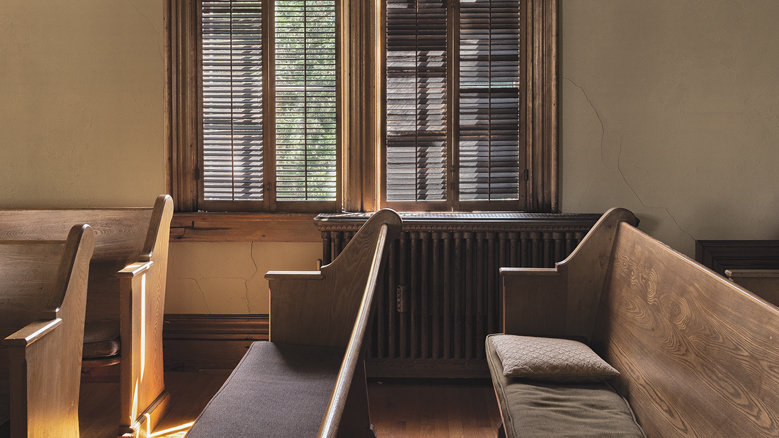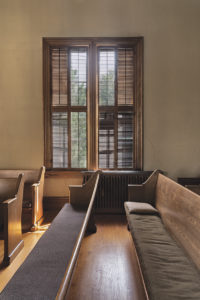
I have attended Westerly (R.I.) Meeting for a number of years. It is held in an old, venerable structure full of silence and peace. When Jean Schnell came to photograph our worship space, I was inspired to look more deeply at those things in front of my eyes and wrote these four little meditations to accompany her photographs.
 Quilts
Quilts
Walking into the Westerly, Rhode Island, meetinghouse on a day when no one has yet come in, we are met by a silence that wraps around us gently like a comforter. There is a palpable sense of those before us who came to worship here. The silence is layered with a history of faithfulness, something like the batting in a quilt, something we do not see but can feel, and it warms us. As we sit here in worship, we will be adding to this history for Friends who will worship here in the future.
Scattered among the benches are colorful quilts that are available on the cold days when the furnace struggles to warm our old, historic building. The quilts are a patchwork, made by many hands, the way any community is a patchwork thing, created by the work of many.
Most spiritual traditions tell us we are one though many: in Hinduism, there is the Net of Indra; in Buddhism, as taught by Thich Nhat Hanh, there is Interbeing; in the Christian tradition, there is the teaching that together we are the body of Christ.
Gazing at the quilts in the quiet sanctuary, might we see into them deeply? Could we let them help us remember that we are of different colored skins, of different genders, of different backgrounds and history, and yet in willingness and faith, we are ultimately sewn together to serve and be comforters for each other?
Simple, palpable things like our meeting quilts—so lovingly made—can be for us visual and somatic prompts to enter into the truth of our oneness.
 The Staircase
The Staircase
At our Rhode Island meetinghouse, we climb a steep set of stairs when we want to enter the worship room from the community room on the ground floor. The stairs are painted a deep reddish-brown. There is a banister to the right, and on the left is the track for the lift chair that disabled Friends use.
To be present to the Presence and action of Spirit within us takes commitment and practice. It is like climbing stairs: that age-old image of spiritual assent and consent. One must do something to participate in the light shared by a community that worships. A staircase reaches up to a new level. Each rung is a step on the journey. Sometimes in our spiritual journeys we get just so far to a landing where we can pause and absorb what has been given and experienced.
In our meetinghouse, there are seven steps to the landing. It’s a place to take a breath, especially if you are elderly, but it is good to pause there anyway. We know steps can be steep in life, and many responsibilities need to be tended to in order to maintain a building and to support a worshiping community. In life, being between levels is a landing we often find ourselves on. It’s a place of integration and rest, and a place of knowing we have further to go. We always have further to go!
We continue, and once we are in the worship room, we listen and cooperate so that we may be folded into the way Spirit wants to work with us and in us. In the silence of the worship room, we are no longer on the landing: we have arrived; we have landed, so to speak. We are in a place where silence and true meeting can be experienced.
When we leave our worship room, we go down those very same stairs and take up our lives in the world. In some Native American spiritual traditions, there are ladders to go down into the kiva, into the earth itself. So, too, in living lives of service and participation, we must go down into the sacred earthiness of the everyday.
Our stairs here at the meetinghouse have a white strip on each edge because one member of the meeting has a visual disability, and this visual aid was thoughtfully provided. It helps her to see where a step ends. As we take steps to act in the world, is it not important to be aware of limits, of what can be done in a given time before going on? These simple white strips are icons of caution and revelation. Here is the end of one step. Take note before going on. Since they are white strips, they can also be simple reminders to practice peace. The strips aren’t peace flags as we usually know them, but they can flag that peace is possible in every step.
Up and down goes the way. Can we be grateful that a step can be taken at all? Down we go, five steps to the landing, a place to pause where the staircase turns.
Sometimes we must make a turn in life that we didn’t expect. A spiritual landing lets us see how to correct our course both as a community and as individuals.
Each time we climb to participate in silent worship, we know that we will soon be descending back down into the world and its needs. The staircase in our meetinghouse serves as a living icon. It is a thing of beauty.
 The Doorknob
The Doorknob
Doorknobs, what wonderful things they are! Turn one and a door opens. It lets you enter a whole new space. Thinking of this in terms of consciousness, we all need those inner doorknobs to open doors into new behavior, new understanding, more love, and willingness to live in mystery instead of clinging to control.
The doorknob on the door to our worship room is low. What thought was there behind that placement? It would be lovely to know. We can imagine that it was deliberately put there so a child could open the door and enter. How considerate is that! Now, when we enter our beloved worship room, we can ask our so-called grown-up selves to step down so that we can be more open and less layered, able to simply be with others in silence and with the small sounds in the room. The play of light strikes the colorful quilts on the back of the benches, and we hear the crunching sound of cars outside when they come down the driveway. We gently absorb these senses and the hidden beauty that is here in everything.
How easily we forget that being is sacred. We need to become more like children and approach the immense gift of now without adult distractions and distancing. Every First Day, we can touch that doorknob that is practically at knee level and let it remind us to be more childlike and open, to receive the precious hour together that we have each week.
 Shutters
Shutters
The wooden shutters in our worship room are very tall and vulnerable. We have to open and close them gingerly. They would be very hard and expensive to replace. We need them to keep the cold out as much as possible when we are not at the meetinghouse, as well as keeping the cost of heat down as low as possible.
These venerable shutters can remind us that we, too, have inner shutters. We need them and they have a purpose. But we also need to remember that shutters are to be opened and closed, not with a bang but gingerly. How to discern such matters takes careful consideration. They are matters of conscience.
The word “conscience” is from the Latin con scientia, to know with. We might think we know ourselves, but we have blind spots. We all have hidden shutters. There is no way we can have integrity without the help of others who will know with us. That is why the Quaker process of holding things in the Light together can be of enormous help in making decisions for the community or when we are in need of a clearness committee.
As just plain human beings, we will falter: we will be unknowing; we will be too open or too closed. But with each other’s wisdom and help, our inner shutters might become more ethical and more appropriate where a boundary must be kept. This takes time. Nothing about conscience can be hurried. It is a process of opening ourselves to what we might not want to know but nevertheless must know and own about our community and ourselves.
The shutters in our worship room have stood the test of time. They still do the job and can remind us that together we can still do the job of moving forward knowing with each other. To be a loving witness and to receive witnessing that is full of care and love is powerful. Discernment is a deep thing Friends do together. It is holy and tender work.



Comments on Friendsjournal.org may be used in the Forum of the print magazine and may be edited for length and clarity.